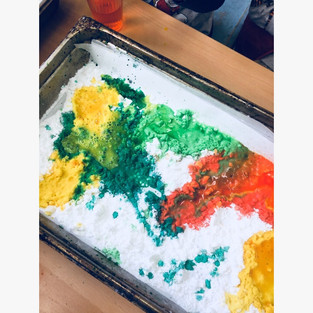STEM Learning: Invitation to experiment with baking soda and vinegar
- Sophia Vidovic White
- Feb 23, 2019
- 3 min read
Friday 15th November
Our group enjoyed a super easy science activity right out of the kitchen cupboard. Today we experimented with an activity that is also a chemical reaction! When an acid and base mix they form a gas called carbon dioxide. Here the vinegar is the acid and the baking soda is the base. This activity is an awesome and safe chemical reaction science experiment that always proves to be popular. Our materials included:
+ box of baking soda (also known as bicarb soda)
+ small bowl of white vinegar
+ medicine dropper (also known as pipette)
+ food colouring
+ baking sheet
The learning outcomes:
+ By using descriptive language to express ideas and explain what they can see happening they are developing their vocabulary.
+ Colour mixing theory.
+ Sensory learning; this activity is great for the senses. The vinegar has a strong smell, the reaction fizzes and is visually appealing while they can also hear it fizzing and smell it. The bicarb has a smooth texture to touch
+ Fine motor skills, motor control & crossing the midline.
+ Cause and effect concepts. If I do this, this will happen.
+ Scientific inquiry: As they play they are making hypothesis and predictions, telling you their observations, they are making comparison, experimenting with their ideas and evaluating the result. This encourages scientific thought processes that enhance learning.
+ Hand-Eye Coordination and Control. Building focus and concentration.
We began by sprinkling baking soda all over the baking sheet. Then we shook the baking sheet back and forth to evenly distribute the baking soda. Next, we set up individual cups full of vinegar and food colouring. We made a coloured vinegar bowl for red, green, yellow, and blue. Using the food colouring and droppers, we squeezed drops of colour all over the baking soda. We watched and listened to each one bubble and fizz. To add to the experience, we used a spray bottle to strengthen muscles and co-ordination in little hands. It was a lot of fun to use but we found that the dropper gave us a more intense reaction.
We had much enjoyment from predicting, testing and experimenting what would happen when one colour mixed with another. They could use any colour or combination of colours. Then they had to carefully use their spoon and get some Bicarbonate soda to mix in to their tube and see what happens. This sometimes required them to cross the bodies’ midline. As our children tested different colours and mixed different colour combinations, they were experimenting with different amounts of vinegar and different measures of Bicarbonate soda. They tried putting the bicarb in first, and then noticed that it got trapped on the bottom. They experimented with adding more coloured vinegar after the bicarbonate soda to keep it fizzing.
The children used different measures of vinegar in different colours and made them have a “race” by tipping in the bicarbonate soda at the same time. The baking paper under their experiments helped the visual effect of the eruptions, as they overflowed and poured onto the paper towel it absorbed it and the colours mixed. Sophie hung hers up to dry and said it was science art.
We could observe our children creating their own work of art as they dripped and dropped until the tray was a collage of colourful craters. And then, as we suspected, they put down their droppers, and sunk their hands into the results of our experiment. This activity was terrific as it satisfied our children’s desire to paint something, without the mess of pulling out the paintbrushes.
The children in our group have such a strong interest in science. Their gasps as they witness a chemical reaction or surprising change is the best way to set their minds off into a flurry of questions and wanting to know more.


















































Comments